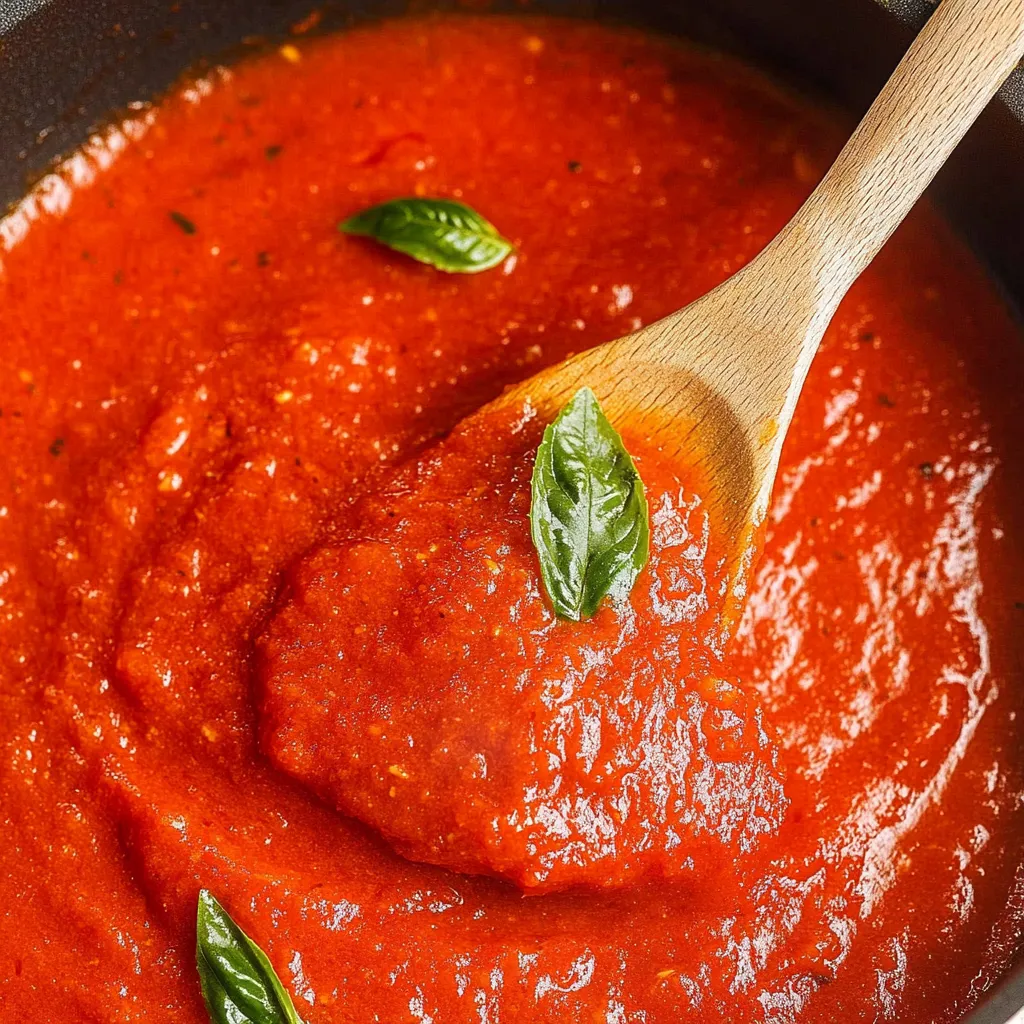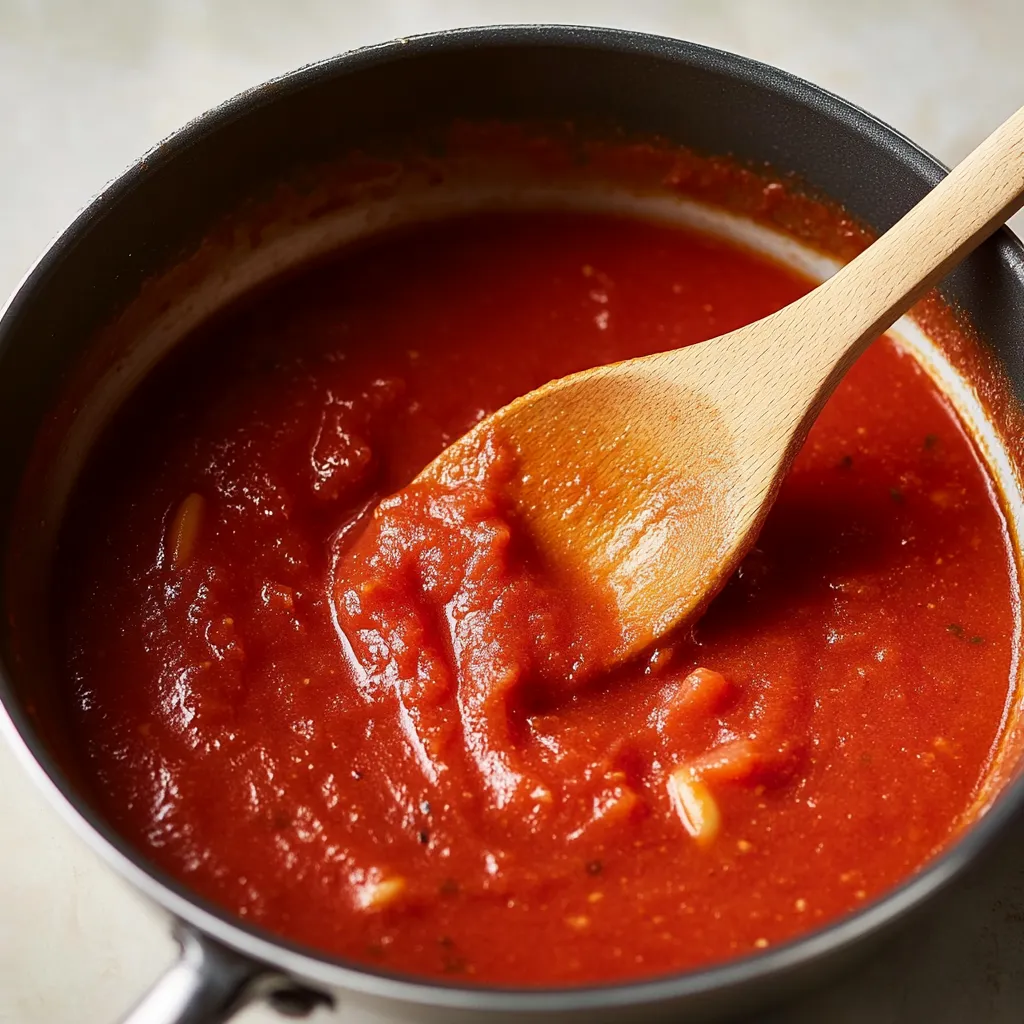 Pin it
Pin it
This classic Italian pomodoro sauce transforms simple ingredients into a velvety, rich tomato sauce that elevates any pasta dish to restaurant quality. With its perfectly balanced flavors and silky-smooth texture, this versatile sauce has the power to transform everyday meals into memorable dining experiences. It's the kind of recipe that becomes a cherished family tradition, passed down through generations for its timeless appeal and incredible versatility.
I made this sauce for my Italian neighbor who is quite particular about his food, and he asked for the recipe before he'd even finished his plate! My daughter, who typically pushes tomato sauce to the side of her plate, actually requested seconds when I served this with penne last weekend.
Ingredients:
- Extra virgin olive oil - The foundation of authentic Italian cooking, providing fruity notes and richness that carries the other flavors. Using a high-quality oil makes a noticeable difference in the final sauce.
- Onion - Creates a savory baseline that adds depth and sweetness when properly sautéed. The natural sugars in the onion caramelize slightly, adding complexity to the sauce.
- Garlic - Provides aromatic pungency that defines Italian cooking. Fresh cloves deliver a brighter, more vibrant flavor than pre-minced varieties.
- Canned tomatoes - The star ingredient that determines the sauce's final flavor. San Marzano tomatoes, with their natural sweetness and low acidity, create the most balanced sauce.
- Sugar - Balances the natural acidity of the tomatoes for a harmonious flavor profile. Even a small amount makes a significant difference in the finished sauce.
- Italian seasoning - A convenient blend of dried herbs that infuses the sauce with classical Italian flavors of basil, oregano, rosemary, and thyme.
- Salt and pepper - Essential seasonings that enhance and unify all the other flavors, transforming separate ingredients into a cohesive sauce.
Instructions:
- Begin with quality aromatics
- by finely dicing one medium onion and mincing 3-4 fresh garlic cloves. The size of your dice matters—smaller pieces will integrate more completely into the final sauce. Heat 3 tablespoons of extra virgin olive oil in a large, heavy-bottomed skillet over medium heat until it shimmers but doesn't smoke. Add the diced onion first and sauté for 3-4 minutes until it becomes translucent and slightly golden around the edges. This slow cooking process breaks down the onion's structure and releases its natural sweetness. Add the minced garlic and cook for just 30-60 seconds more, until fragrant but not browned. Browning garlic creates bitter notes that can overpower the sauce.
- Introduce the tomatoes carefully
- by pouring one 28-ounce can of whole San Marzano tomatoes (with their juice) into the skillet. If using whole tomatoes, gently crush them with a wooden spoon or potato masher as they heat. This manual crushing preserves the fresh tomato texture better than pre-crushed varieties. Bring the mixture to a gentle boil, stirring occasionally to prevent any sticking, then immediately reduce the heat to establish a steady simmer. The bubbles should be small and consistent, gently breaking the surface without splattering. This gentle cooking method allows the flavors to meld while preserving the bright tomato taste.
- Season thoughtfully
- after the sauce has simmered for about 30 minutes and reduced slightly. At this point, add 1 tablespoon of Italian seasoning, 1/2 teaspoon of salt, 1/4 teaspoon of freshly ground black pepper, and 1 teaspoon of sugar. The delayed addition of dried herbs prevents them from becoming bitter during the long simmering process, while still allowing enough time for their flavors to infuse the sauce. Stir well to incorporate all the seasonings evenly throughout the sauce, then continue to simmer for another 1-2 minutes to wake up the dried herbs.
- Achieve silky smoothness
- by turning off the heat and allowing the sauce to cool slightly for a safer blending process. Use an immersion blender directly in the skillet for convenience, or carefully transfer the sauce to a standard blender. Pulse several times, then blend continuously until you reach your desired consistency. For authentic pomodoro, the texture should be completely smooth without any visible chunks of onion or tomato. If using a standard blender, work in batches if necessary and leave the pour spout slightly open with a kitchen towel over it to allow steam to escape.
- Perfect the consistency
- by returning the pureed sauce to the skillet if you used a standard blender. Simmer for a few more minutes, allowing the sauce to thicken slightly to the ideal texture that will cling to pasta rather than pool at the bottom of the plate. If the sauce seems too thick, add a few tablespoons of pasta cooking water or regular water to adjust. The perfect pomodoro sauce should coat the back of a wooden spoon smoothly but not be watery or too thick like paste.
- Finalize with pasta
- by cooking 12 ounces of penne (or your pasta of choice) in heavily salted water until al dente, typically 1-2 minutes less than the package instructions. Before draining, reserve about 1 cup of the starchy pasta water. Add the drained pasta directly into the skillet with the sauce, tossing gently to coat each piece thoroughly. Add splashes of the reserved pasta water as needed to loosen the sauce and create a silky texture that clings perfectly to the pasta. The starch in the pasta water helps the sauce adhere to the noodles better than plain water would.
- Serve with final touches
- by transferring the sauced pasta to warmed serving bowls. Garnish with torn fresh basil leaves, which add bright aromatic notes that perfectly complement the cooked sauce. A light drizzle of high-quality extra virgin olive oil and a sprinkle of freshly grated Parmesan cheese add the finishing touches that elevate this simple dish to something truly special. The warm pasta will slightly wilt the basil, releasing its essential oils and perfuming the entire dish.
 Pin it
Pin it
I discovered that adding just a splash (about 1 tablespoon) of good red wine to the onions and garlic just before adding the tomatoes adds remarkable depth to the sauce. The alcohol cooks off completely, but it helps release flavor compounds in the tomatoes that are alcohol-soluble rather than water-soluble, creating a more complex finished sauce. My grandmother never wrote this step down in her recipe, but I noticed she always did it!
The San Marzano Secret
The variety of tomatoes you choose significantly impacts the final flavor of your pomodoro sauce. San Marzano tomatoes, grown in the volcanic soil near Mount Vesuvius in Italy, contain less acidity and more natural sweetness than regular plum tomatoes. They also have fewer seeds and a meatier texture, creating a naturally richer sauce. When shopping for San Marzano tomatoes, look for cans labeled "D.O.P." (Denominazione d'Origine Protetta), which guarantees they're authentic. If true San Marzanos aren't available, other high-quality Italian plum tomatoes make good substitutes. During summer months when fresh tomatoes are at their peak, you can use ripe Roma tomatoes instead—simply blanch them in boiling water, peel, seed, and chop before using. The fresh version will be lighter in color and slightly more delicate in flavor but equally delicious in a different way.
Perfect Pasta Pairings
While pomodoro sauce works beautifully with virtually any pasta shape, certain pairings enhance the eating experience. Long, thin pasta like spaghetti or linguine allows the smooth sauce to coat each strand evenly, creating the perfect sauce-to-pasta ratio in every bite. For a more substantial dish, tubular pastas like penne or rigatoni capture pockets of sauce within their hollow centers. For a truly traditional experience, try handmade fresh pasta, which has a slightly rougher texture that helps the sauce cling better than factory-made dried varieties. When serving, remember the Italian philosophy that pasta should be dressed, not drowned—use just enough sauce to coat the pasta completely without pooling at the bottom of the plate. This approach showcases both the pasta and the sauce as equal partners rather than letting either one dominate.
Creative Uses Beyond Pasta
While pomodoro sauce shines most brilliantly when tossed with pasta, its versatility extends far beyond traditional applications. Use it as a base for shakshuka by creating wells in the warm sauce and cracking eggs directly into them, then covering until the eggs are perfectly set. Spread a thin layer on homemade pizza dough for a smoother alternative to chunky pizza sauce. Use it as a flavorful poaching liquid for white fish like cod or halibut. Simmer meatballs directly in the sauce for added richness. Create a quick soup by adding vegetable broth and small pasta shapes like ditalini. For an elegant appetizer, spread it on crostini and top with a slice of fresh mozzarella. The balanced flavor profile of pomodoro sauce makes it a perfect foundation for countless dishes beyond the expected Italian classics.
I learned this pomodoro sauce recipe from my mother, who learned it from her mother in a small town outside Naples. What makes our family version special is the technique of properly sautéing the onions until truly translucent before adding the garlic—many recipes rush this step, but the extra few minutes transforms the onion's sharp flavor into sweet, aromatic depth. When I make this sauce, the fragrance that fills my kitchen instantly transports me to Sunday afternoons in my mother's kitchen, where this sauce simmered weekly without fail. There's something profoundly satisfying about continuing this tradition, creating a sauce so simple yet so perfect that it needs no improvement after generations of testing.
Frequently Asked Questions
- → Can I use fresh tomatoes instead of canned?
- Yes! Use about 3 pounds of fresh tomatoes. Blanch, peel and dice them first. The flavor will be different but delicious.
- → How long does this sauce keep in the fridge?
- The sauce keeps well in the fridge for up to 7 days in an airtight container.
- → Can I skip blending the sauce?
- Absolutely! If you prefer a chunkier texture, just crush the tomatoes with a spoon while cooking instead of blending.
- → What pasta works best with pomodoro sauce?
- This sauce works with any pasta shape, but traditionally it's paired with spaghetti, penne, or rigatoni to hold the smooth sauce.
- → Can I add vegetables to this sauce?
- Yes! Diced carrots, celery, or bell peppers work well. Add them with the onions for extra flavor and nutrition.
- → Is this sauce spicy?
- No, this classic version isn't spicy. Add red pepper flakes while cooking if you want some heat.
